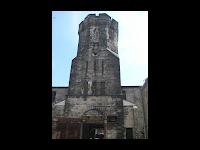Before our visit to the Eastern State Penitentiary I was a little nervous about entering the imposing building. What would it be like locked inside? It turns out, quite pleasant. The folks there have done amazing work restoring the site, and their archives are quite unique.
The Eastern State Penitentiary began as an experiment in 1790 at the Walnut Street Jail with 16 cells designed to house a single prisoner each day and night in solitary confinement. This first “Penitentiary House” was meant to create a space where a prisoner could feel penitent about his crimes, thus the name. This experiment grew into a plan to build a full scale building to hold 250 prisoners. Designed by John Haviland, construction for the building began in 1822.
 By 1829 the penitentiary was ready to receive its first prisoners. The prison has been designed to prohibit all contact between prisoners, even providing private exercise yards for each. The penitentiary’s first inmate is named Charles Williams who was sentenced for burglary and confined for two years at Eastern State.
By 1829 the penitentiary was ready to receive its first prisoners. The prison has been designed to prohibit all contact between prisoners, even providing private exercise yards for each. The penitentiary’s first inmate is named Charles Williams who was sentenced for burglary and confined for two years at Eastern State.
As soon as 1831 the prison accepted its first female prisoners and it would maintain female cell blocks until 1923. Over the years that the penitentiary was in operation it housed some very well-known names such as Al Capone, the infamous gangster and Willie Sutton, the notorious bank robber. In 1913 the plan for individual confinement and penitence is officially abandoned and by 1926, with the construction of new cell blocks, the penitentiary’s population grew to 1700 inmates. Multiple riots occur over the next few decades, many stemming from prison overcrowding. In 1961 the prison cell blocks are desegregated, and in 1971 the prison officially closes its doors to inmates.
 This National Historic Landmark has a rich and sometimes haunting past, which is put to great use each fall with, “Terror Behind the Walls”, a Halloween fundraiser held every year since 1991. For our purposes Eastern State Penitentiary also maintains a rich and unique archives which holds information on past inmates, the building, employees, as well as artwork created by the prisoners. One of our favorite holdings of the archives is a box of handmade “shivs” which were made by inmates. You can find descriptions of the collections at Eastern State on the PACSCL finding aid website.
This National Historic Landmark has a rich and sometimes haunting past, which is put to great use each fall with, “Terror Behind the Walls”, a Halloween fundraiser held every year since 1991. For our purposes Eastern State Penitentiary also maintains a rich and unique archives which holds information on past inmates, the building, employees, as well as artwork created by the prisoners. One of our favorite holdings of the archives is a box of handmade “shivs” which were made by inmates. You can find descriptions of the collections at Eastern State on the PACSCL finding aid website.
There are many reasons to visit Eastern State Penitentiary, for a tour, for a fright, and for in-depth research into the history of prison systems in our country.

